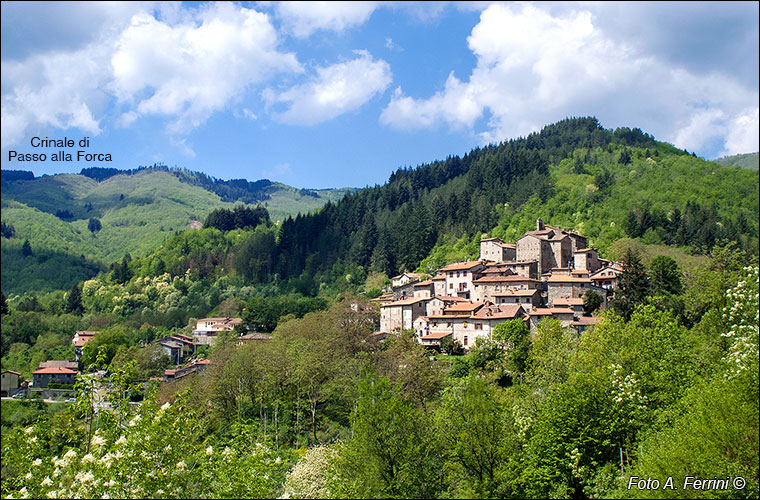Carda
in Casentino, una bella valle Toscana che puoi conoscere in ogni suo dettaglio con questo sito
Italiano
UN BORGO SU UN PICCOLO COLLE
Da Castel Focognano abbiamo ripreso la strada per Carda. Poco prima di giungere al piccolo borgo incontriamo un bivio. Noi dobbiamo andare a sinistra, ma se proseguiamo per qualche centinaio di metri a destra, sulla strada che conduce a Calleta, avremo questa vista di Carda: un'immagine con direzione opposta rispetto alla foto della prima pagina di questa sequenza che mostrava un panorama da Passo alla Forca verso il Casentino con Carda adagiata tra i monti. Quest'immagine ben ci mostra la conformazione del piccolo borgo montano nel Comune di Castel Focognano, con la chiesa posta nel punto più alto. A primo impatto questa vista fa sembrare Carda adagiata sulle pendici della montagna, in realtà è posta su un piccolo colle e quindi si estende oltre rispetto a quanto vediamo da qui. In origine Carda, citata come Garda in antichi documenti, era sicuramente un piccolo centro fortificato di probabile origine longobarda circoscritto all'attuale parte più alta del paese. Dal periodo post longobardo a metà XIV secolo il luogo fu sottoposto la giurisdizione di Arezzo. Attorno al 1360, gli Ubertini, Signori del luogo, essendo i fiorentini in fase di avanzamento e già presenti nell'adiacente valle del Teggina (attuale Comune di Ortignano Raggiolo), lasciarono Carda non prima di averla donata ai vicini monaci di Badia Santa Trinita. Da quel momento nasce tra questi due luoghi un forte legame tutt'oggi sentito dagli abitanti del piccolo borgo. Legame che giustifica lo spostamento, nel 1570, del polittico di Mariotto di Cristofano da Santa Trinita a Carda (pagina 23 di questa sequenza).
From Castel Focognano we took the road to Carda. Just before reaching the small village we come across a fork in the road. We have to go left, but if we continue for a few hundred meters to the right, on the road that leads to Calleta, we will have this view of Carda: an image with the opposite direction to the photo on the first page of this sequence that showed a panorama from Passo alla Forca towards Casentino with Carda nestled between the mountains. This image shows us well the conformation of the small mountain village in the Municipality of Castel Focognano, with the church located at the highest point. At first glance this view makes Carda seem to be nestled on the slopes of the mountain, in reality it is located on a small hill and therefore extends further than what we see from here. Originally Carda, cited as Garda in ancient documents, was certainly a small fortified center of probable Lombard origin limited to the current highest part of the town. From the post-Lombard period to the mid-14th century the place was under the jurisdiction of Arezzo. Around 1360, the Ubertini, Lords of the place, since the Florentines were advancing and already present in the adjacent Teggina valley (current Municipality of Ortignano Raggiolo), left Carda not before having donated it to the nearby monks of Badia Santa Trinita. From that moment a strong bond was born between these two places that is still felt today by the inhabitants of the small village. A bond that justifies the movement, in 1570, of the polyptych by Mariotto di Cristofano from Santa Trinita to Carda (page 23 of this sequence).

















































